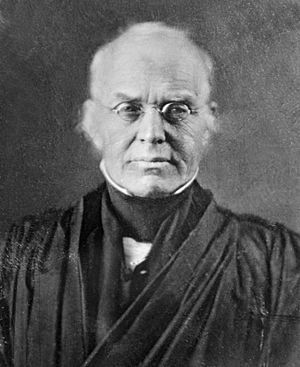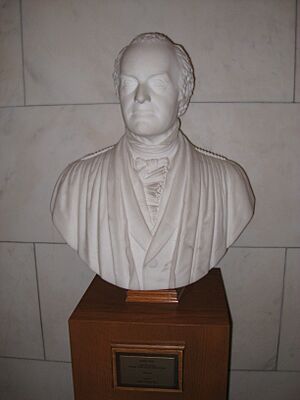Joseph Story facts for kids
Quick facts for kids
Joseph Story
|
|
|---|---|
 |
|
| Associate Justice of the Supreme Court of the United States | |
| In office February 3, 1812 – September 10, 1845 |
|
| Nominated by | James Madison |
| Preceded by | William Cushing |
| Succeeded by | Levi Woodbury |
| Member of the U.S. House of Representatives from Massachusetts's 2nd district |
|
| In office May 23, 1808 – March 3, 1809 |
|
| Preceded by | Jacob Crowninshield |
| Succeeded by | Benjamin Pickman |
| Personal details | |
| Born | September 18, 1779 Marblehead, Massachusetts, U.S. |
| Died | September 10, 1845 (aged 65) Cambridge, Massachusetts |
| Political party | Democratic-Republican |
| Education | Harvard University (AB) |
Joseph Story (born September 18, 1779 – died September 10, 1845) was a very important American lawyer and judge. He served as an Associate Justice on the highest court in the United States, the Supreme Court, from 1812 to 1845.
He is best known for his important legal opinions and for his book, Commentaries on the Constitution of the United States. This book, first published in 1833, helped shape how American law was understood. It was one of the first complete books explaining the U.S. Constitution. It is still a key source of information about how the American republic was formed.
Story believed in protecting property rights. He thought that popular majorities should not take away the rights of people who owned property. Historians agree that Story helped shape American law in a way that protected these rights.
He was honored in the movie Amistad. In the film, retired Supreme Court Justice Harry Blackmun played Joseph Story. Blackmun read the Supreme Court's decision in the real case the movie was based on. This was the only time one Supreme Court justice has played another in a movie!
Contents
Early Life and Education
Joseph Story was born in Marblehead, Massachusetts. His father, Dr. Elisha Story, was a member of the Sons of Liberty. He even took part in the famous Boston Tea Party in 1773.
Joseph studied at the Marblehead Academy. He then went to Harvard University in 1795. After graduating from Harvard, he studied law. He became a lawyer in July 1801.
Story practiced law in Salem. He was a member of the Democratic-Republican Party. He served in the Massachusetts House of Representatives from 1805 to 1807. In 1808, he was elected to the United States House of Representatives. He served a short term there. In 1811, he returned to the Massachusetts House. He was chosen to be the Speaker of the House.
Joseph Story married Mary Lynde Fitch Oliver in 1805, but she sadly died soon after. In 1808, he married Sarah Waldo Wetmore. They had seven children, but only two lived to be adults. Their son, William Wetmore Story, became a famous poet and sculptor. He later wrote a book about his father's life.
Story was known for his good humor. He believed everyone should laugh for at least an hour each day. He had many funny stories to share.
Serving on the Supreme Court
On November 15, 1811, President James Madison chose Joseph Story to be an Associate Justice of the Supreme Court. He was only 32 years old. This made him the youngest person ever nominated to the U.S. Supreme Court. The Senate approved his nomination. He officially started his job on February 3, 1812.
One of Story's most important opinions was in the case of Martin v. Hunter's Lessee (1816). In this case, Story said that the U.S. Constitution was created by "the people of the United States," not just by the states. He believed the Supreme Court needed to have power over state courts. This was to make sure laws were the same everywhere. He thought that if each state had its own different laws, it would harm the country.
Story also wrote the majority opinion in Prigg v. Pennsylvania (1842). This case was about a Pennsylvania law that made it harder to capture runaway slaves. Even though Story did not like slavery, he ruled that the Pennsylvania law was unconstitutional. He felt that the U.S. Constitution, which was a deal made when the country was formed, protected the right of slaveholders to get their runaway slaves back. He believed he had to honor this part of the Constitution to keep the Union strong.
Another important case was Swift v. Tyson (1842). In this case, Story helped create "federal common law." This meant that federal judges could make legal rules that applied across the country. Before this, courts often had to use state laws. Story wanted federal judges to have more power to create uniform laws. This decision was very important for American law.
Life at Harvard Law School
In 1829, Joseph Story moved to Cambridge. He became the first Dane Professor of Law at Harvard University. He was a very successful teacher. His students loved learning from a sitting Supreme Court justice.
Story was also a very busy writer. He wrote many articles and books about law. His books were praised in both America and Europe. One of his most important works was his Commentaries on the Constitution. In this book, Story explained his ideas about the Constitution. He argued that the power came from the people, not from the states. He wanted a strong national government. He believed this would keep the country stable.
Story also helped develop a legal tool called remittitur. This allows a judge to reduce the amount of money a jury awards in a civil lawsuit if it seems too high. Story's idea was very important. It is now used in courts across the United States.
Why Joseph Story Was Important
Justice Story is one of the most important people in early American legal history. He wrote many more opinions than almost any other justice on the Supreme Court during his time.
Story believed in "legal science." This meant he thought laws should be applied in a consistent way everywhere. He believed that a strong national government and federal courts were important. They could help create a more unified country. While some of his decisions, like Prigg, were controversial, he always aimed to protect the Union. His ideas helped shape American law and the role of the Supreme Court.
Works by Joseph Story
Joseph Story was a very successful author. He earned a lot of money from his books.
Some of his important books include:
- Commentaries on the Law of Bailments (1832)
- Commentaries on the Constitution of the United States (3 volumes, 1833) – This is still a key book on the Constitution.
- Commentaries on the Conflict of Laws (1834) – Many people think this is his most important work.
- Commentaries on Equity Jurisprudence (2 volumes, 1835–1836)
- Law of Agency (1839)
- Law of Partnership (1841)
He also edited other legal books. His collected Miscellaneous Writings were published in 1835.
Death and Legacy
Justice Story gave a speech at the opening of Mount Auburn Cemetery in 1831. This speech helped start the "rural cemetery" movement in America. He talked about how these cemeteries could help create an orderly country.
Joseph Story died in 1845. He is buried at Mount Auburn Cemetery. His grave has a statue made by his son, William Wetmore Story.
Story County, Iowa is named after him.
Images for kids




